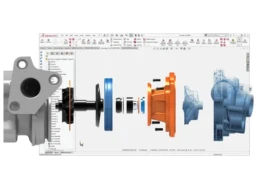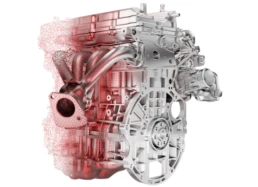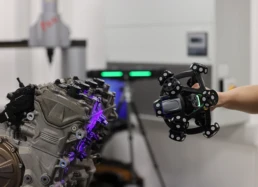Exploring the Benefits of 3D Scanning: Transforming Industries and Innovation

Handheld 3D scanners are revolutionising industries ranging from automotive to aerospace and power generation. By providing unmatched precision, speed, and convenience, these cutting-edge tools are transforming how engineers and specialists perform quality control (QC) and reverse engineering.
Whether you’re a manufacturing engineer, quality control specialist, product designer, or metrology expert, understanding the potential of this technology is key to staying competitive in a data-driven world. This guide dives deeply into how handheld 3D scanners enhance accuracy, efficiency, and cost-effectiveness. Plus, we’ll discuss real-world use cases, key features to consider, and how to select the right scanner for your needs.
Why Handheld 3D Scanners Are the Future of Quality Control
Precision Measurement Made Simple
One of the most appealing aspects of handheld 3D scanners is their capability to deliver incredibly high accuracy, often down to micrometers. Advanced technologies, such as the SIMSCAN-E, NIMBLETRACK, and TRACKSCAN SHARP-S employ blue light laser technology to create highly detailed 3D representations of objects.
This level of precision is invaluable for maintaining tight tolerances in industries like aerospace and automotive, where even the smallest deviation can have significant consequences. Unlike traditional inspection tools, handheld 3D scanners can perform non-contact measurements, reducing risks of damage or disruptions to the surface.
Not only does this make inspections faster, but it also eliminates the need for extensive fixturing and environmental controls—a common pain point in conventional QC methods.

Enhanced Efficiency in Inspection
Time is money, and handheld 3D scanners excel at saving both. Features such as rapid data capture mean these devices can gather hundreds of thousands of data points in just seconds, drastically reducing inspection times. A process that once took hours can now be completed in mere minutes.
Take the automotive sector as an example. Components are often scanned directly on the production line to ensure they meet exact specifications, preventing costly recalls or production delays. Additionally, their portability allows engineers to conduct inspections in any environment—whether on-site, in confined spaces, or in a dedicated production lab.
Cost-Effectiveness Over Time
By enabling fast issue detection early in the manufacturing or prototyping stages, handheld 3D scanners minimise rework, defects, and downtime. Traditional measurement equipment often requires multiple setups or specialised infrastructure, inflating costs. Portable 3D laser scanners, on the other hand, streamline workflows while offering an excellent return on investment (ROI).
Applications of Handheld 3D Scanners in Industry
Quality Control Across Multi-Sector Workflows
Whether it’s aerospace parts, automotive gear assemblies, or heavy-duty power-generation turbines, handheld 3D scanners cater to various quality control needs. By capturing fine surface details and detecting microscopic imperfections, these scanners ensure components meet regulatory and safety standards.
Reverse Engineering Precision Components
Reverse engineering allows companies to create accurate digital models of outdated or unavailable components. Portable 3D scanners are particularly valuable for capturing the complex geometries of an object, enabling engineers to reproduce or enhance its design.
For example, in the aerospace industry, scanning legacy aircraft parts ensures manufacturers can craft replacements without relying on original blueprints. Similarly, power-generation companies rely on industrial 3D scanners for turbine blade reconstruction, eliminating the need for manual redesigns.
Supporting Product Development
Design and prototyping departments can utilise handheld 3D scanners to refine products, saving weeks of iteration and testing. Designers can digitally manipulate the scanned data to simulate functionality, investigate design flaws, or introduce aesthetic changes—all without physical trial and error.
Essential Features to Look for in a Handheld 3D Scanner
Investing in the right handheld 3D scanner is critical for long-term success. Here are the top features experts should prioritise when selecting a device:
Accuracy and Resolution
Search for precision tools that offer metrology-grade accuracy (e.g., 20 µm) and high resolution to capture fine details. Lower-grade scanners may save costs initially but result in inferior outcomes.
Portability
Lightweight and compact designs matter, especially for engineers who work in varied environments. Wireless operation is a bonus, allowing greater flexibility and reducing clutter during operation.
Non-Contact Scanning
Ensure the scanner provides non-contact measurements, as this reduces the need for physical markers and avoids potential surface damage during inspection.
Speed and Agility
Rapid data capture and ease of setup are essential for high-efficiency workflows. Devices like Scantech’s NIMBLETRACK excel in eliminating tedious setup processes and enabling faster scans.
Advanced Software Integration
Reliable software is equally as crucial as hardware. Look for scanners accompanied by intuitive software that simplifies data processing and integrates seamlessly with design or metrology platforms like CAD.
Advanced Software Integration
Not all 3D scanners are created equal. For specific applications, consider models tailored to your industry. For instance, TRACKSCAN SHARP-S models are ideal for large-scale projects, while SIMSCAN-E offers an all-in-one solution for confined or intricate spaces.
Real-World ROI of Handheld 3D Scanners
By replacing outdated measurement setups with handheld 3D scanners, companies achieve measurable ROI within months. Design teams have shorter TATs (turnaround times), production lines face fewer halts, and quality assurance rarely misses a beat.
To illustrate, automotive manufacturers who used handheld scanners reduced fixture installation times by 30% and saw a 20% improvement in defect detection rates. Such advancements ensure businesses maintain their competitive edge, especially within highly regulated industries.
Optimise Workflows with Handheld 3D Scanners
Handheld 3D scanners are more than just tools—they’re a gateway to precision, efficiency, and innovation. From improving quality control protocols to enabling cost-efficient reverse engineering, these devices empower professionals to achieve their goals with unmatched confidence.


